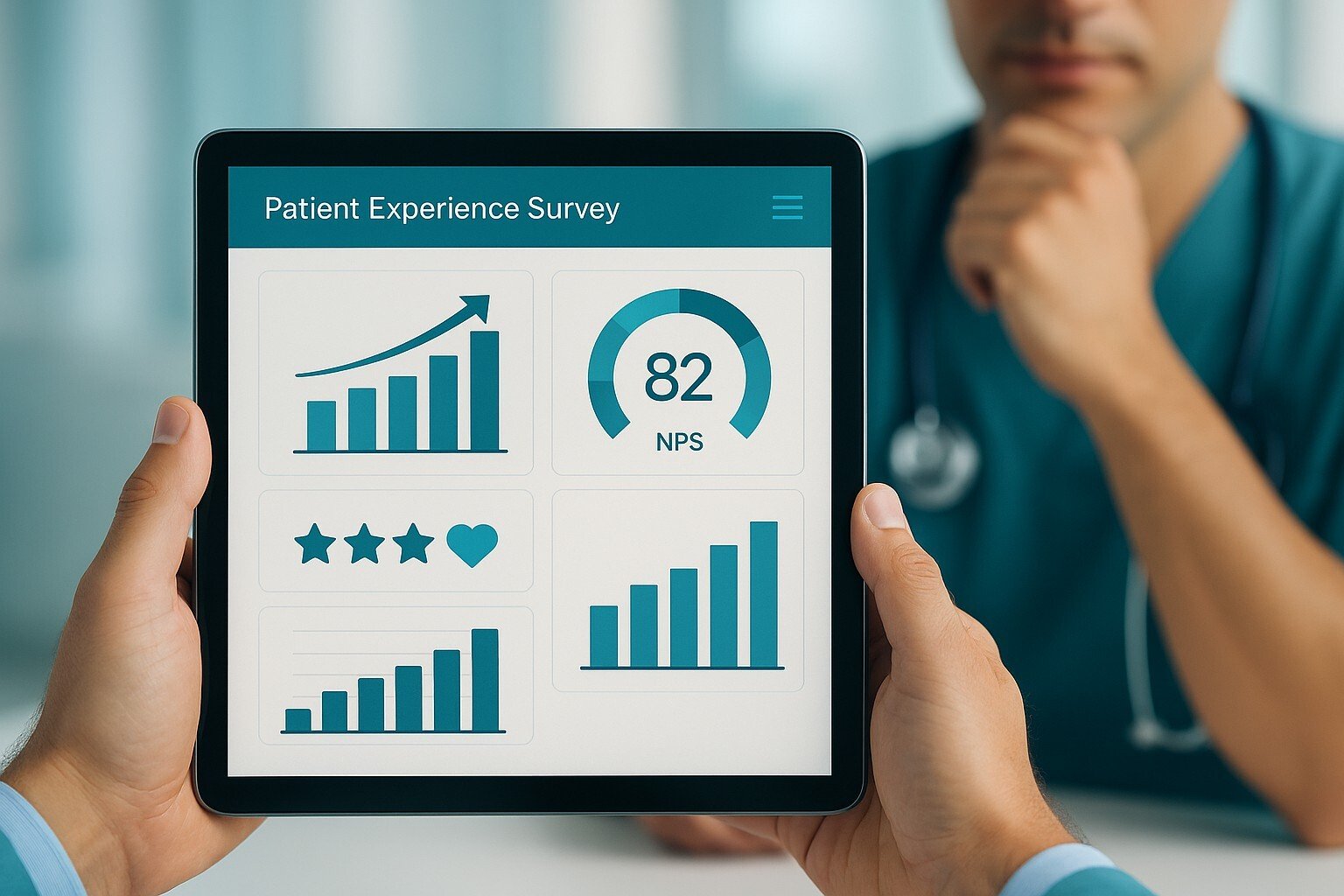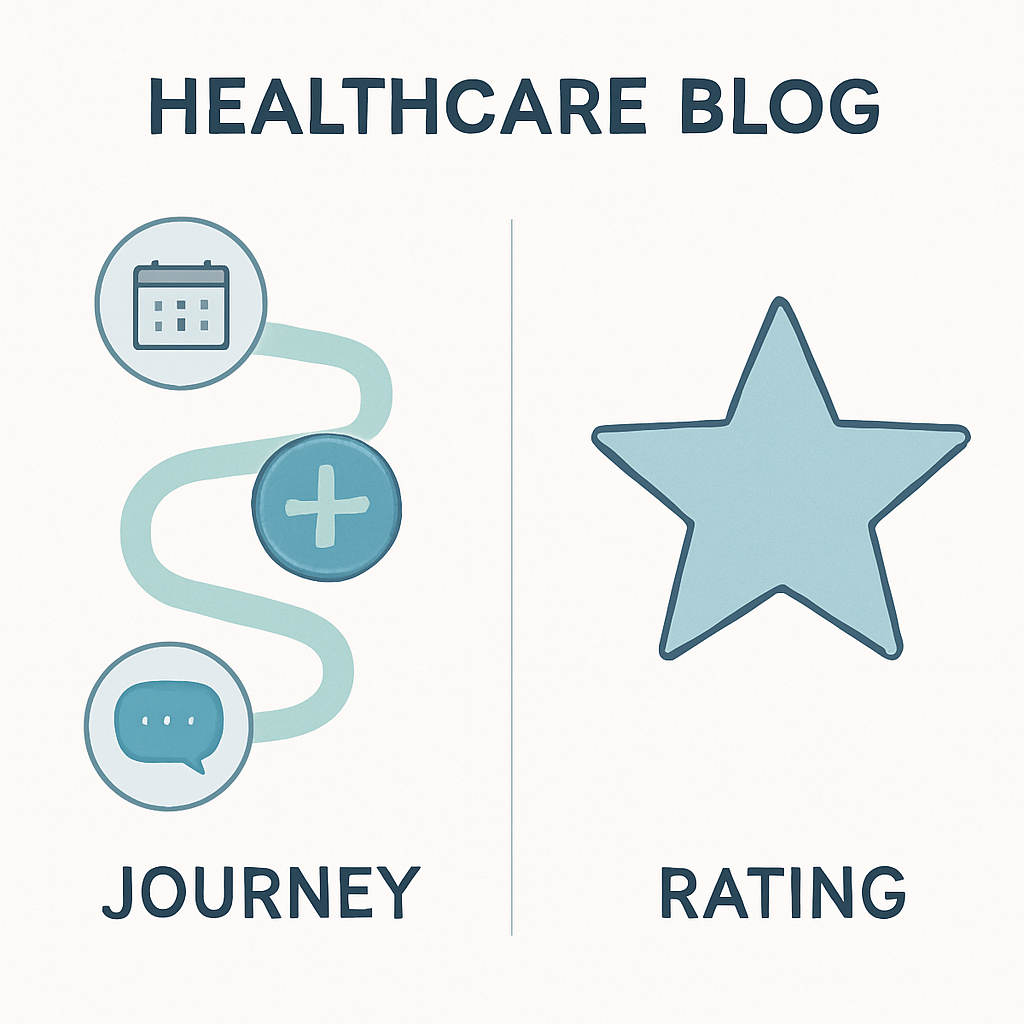55+ Patient Satisfaction Survey Questions, Templates and Strategies
A patient satisfaction survey is a critical tool that provides a direct line of communication between healthcare providers and the people they serve....
11 min read
Alvin Amoroso : 7/21/25 9:00 AM

Imagine two patients leave your clinic. One felt rushed, confused by the billing, and unsure about their treatment plan. The other felt heard, respected, and confident in their care. The actual medical treatment they received might have been identical, but their experiences were worlds apart. A patient experience survey is the critical instrument that allows healthcare organizations to see their practice through the patients' eyes, moving beyond clinical metrics to understand and improve the human side of care.
By systematically gathering feedback on specific patient interactions, these surveys offer a clear, data-driven view into operational strengths and weaknesses. This article provides a comprehensive overview of the patient experience survey, covering the key questions to ask, good practices for creation and implementation, and a detailed guide on how to analyze and act on the feedback you receive. We will explore the fundamental difference between patient experience and satisfaction, provide an adaptable patient experience survey template, and detail the essential tools and processes required to turn patient feedback into a powerful engine for organizational improvement, impacting everything from patient safety to financial performance.
Understanding the precise definition of a patient experience survey and its profound strategic importance in today's healthcare landscape is the first step toward leveraging it effectively.
A patient experience survey is a formal, scientific questionnaire designed to collect feedback from patients about the specific, objective events they encountered during an episode of care. It is distinct from a satisfaction survey, which measures subjective feelings. An experience survey rigorously asks what happened, gathering data on observable aspects of care, such as:
By focusing on these measurable interactions, a patient experience survey provides structured data that can be used to assess process quality, ensure adherence to evidence-based best practices, and benchmark performance against internal goals and national standards.
In the era of value-based care, patient experience is no longer a "soft" metric; it is a core component of reimbursement models and quality reporting. Government and private payers are increasingly tying financial payments to the quality of care delivered, and patient experience surveys are the primary tool for measuring it.
Major programs like the Hospital Consumer Assessment of Healthcare Providers and Systems (HCAHPS) are mandated by the Centers for Medicare & Medicaid Services (CMS). HCAHPS scores are publicly reported and are used in the calculation of value-based incentive payments to hospitals. Low scores can lead to significant financial penalties, while high scores can result in bonuses.
Similarly, under the Medicare Access and CHIP Reauthorization Act (MACRA), physician performance is evaluated through the Merit-based Incentive Payment System (MIPS). A significant portion of a clinician's MIPS score is derived from Quality and Improvement Activities, which often include patient experience measures. A well-executed patient experience survey program is therefore not just good practice—it's a financial and regulatory necessity. It provides the data needed to identify areas for improvement, demonstrate quality to payers, and ultimately thrive in a system that pays for value, not just volume.
Integrating patient experience surveys into your quality improvement strategy offers significant, tangible benefits for providers, patients, and the organization as a whole.
The design of your survey is a science. The structure, question types, and psychological principles you apply will determine the validity and reliability of the data you collect.
To ensure your survey is a credible measurement tool, it's important to understand two core psychometric concepts:
Focusing on validity and reliability from the start ensures the data you collect is accurate, credible, and forms a solid foundation for decision-making.
Creating a robust survey is a structured process that moves from high-level strategy to detailed execution.
First, define your goals with precision. A poor goal is "We want to improve our practice." A good, measurable goal is "We want to reduce the average patient-reported wait time by 15% in the next quarter" or "We aim to increase the 'likelihood to recommend' score for Dr. Smith by 10% within six months." These specific goals dictate exactly what you need to measure.
Second, choose the right survey method. A multi-channel strategy is best. Deploy surveys via email and SMS for timeliness and high open rates, but also have QR codes or tablets available in the office to capture feedback from less tech-savvy populations or those who prefer to respond on-site.
Third, craft meticulously clear and unbiased questions. A leading question like "Don't you agree our new waiting room is much better?" will produce useless data. An unbiased question asks, "How would you rate the comfort and cleanliness of our waiting room?" Review every question to remove jargon, ambiguity, and bias.
Fourth, structure the survey for a seamless user experience. Group the ~25 questions into logical sections with clear headings (e.g., "About Your Appointment," "Your Care Team," "Overall Impression"). This creates a mental map for the user, making the survey feel shorter and more organized, which significantly increases completion rates.
Finally, pilot test your survey rigorously. Administer the draft survey to a small group of staff and a handful of trusted patients. Ask them not only to take the survey but to critique it. Was anything confusing? Did any question make them uncomfortable? This feedback is invaluable for refining your instrument before a full-scale launch.
A survey is only representative if it is accessible to your entire patient population. This is a matter of both good practice and health equity.
Using a standardized patient experience survey template is a cornerstone of good practice. It ensures you are asking validated, reliable questions and allows you to benchmark your performance over time. A template should be seen as a starting point, which you can customize for different specialties. For instance, a mental health survey might add questions about therapeutic alliance, while a dental survey would include questions about pain management.
Below is a comprehensive question bank you can adapt.
Section 1: Access to Care
Section 2: Arrival & Waiting 4. Please rate the courtesy and professionalism of the front desk staff. 5. How long did you wait in the reception area after your scheduled appointment time? 6. How would you rate the overall cleanliness and comfort of our waiting room?
Section 3: Your Care Team (Nurses, Medical Assistants) 7. During this visit, did our nursing staff treat you with courtesy and respect? 8. Did our nurses listen carefully to your health concerns? 9. Did the staff clearly explain any procedures before they were performed?
Section 4: Your Provider (Doctor, PA, NP) 10. Did your provider greet you in a warm and friendly manner? 11. Did your provider spend enough time with you? 12. Did your provider explain things in a way that was easy for you to understand? 13. Did your provider involve you in decisions about your treatment and care as much as you wanted to be involved? 14. Did you have confidence and trust in your provider?
Section 5: Facility and Environment 15. Was our facility easy to find and navigate with clear signage? 16. Did you feel your personal privacy was respected during all parts of your visit?
Section 6: Check-out, Billing & Follow-Up 17. How would you rate the efficiency and friendliness of the check-out process? 18. How easy was it to understand your most recent bill from our office? 19. Did you receive clear instructions regarding follow-up care, medications, and future appointments? 20. Were your test results communicated to you in a timely and clear manner?
Section 7: Overall Experience 21. Overall, how would you rate the quality of care you received during this visit? (Scale of 1-10) 22. How likely are you to recommend our practice to your friends and family? (0-10, Net Promoter Score question) 23. What is the single most important thing we could do to improve our care? (Open-ended) 24. Please use this space to recognize any specific staff member who provided you with outstanding service. (Open-ended) 25. Based on this visit, do you intend to return to our practice for your future care? (Yes/No)
A brilliant survey is useless if no one takes it. Your distribution strategy is just as important as your survey design.
Data collection is a prelude to the most important work: turning insights into action.
Start by calculating average scores, but don't stop there. Segment your data to uncover deeper insights. Compare scores between different locations, providers, or patient demographics. This is how you discover that while your overall communication score is high, one specific department is struggling.
A key metric to adopt is the Net Promoter Score (NPS), derived from the "likelihood to recommend" question. Patients are grouped into:
The open-ended comments are where the data comes to life. Use a process called thematic analysis. Read through the comments and group them into recurring themes like "billing confusion," "staff compassion," or "parking difficulty." Then, use sentiment analysis (either manually or with software) to tag these themes as positive, negative, or neutral. This quantifies your qualitative data, allowing you to say, "25% of all negative comments this month related to our phone system."
The goal is to create a self-reinforcing cycle of improvement.
A patient experience survey is a structured questionnaire used by healthcare organizations to gather objective feedback from patients about what happened during their care. It focuses on specific, measurable aspects of their journey—like communication with doctors, wait times, and facility cleanliness—to identify areas for quality improvement.
The 5 P's of patient experience is a comprehensive framework used to ensure all key domains of care are assessed. A common model includes:
The 4 P's is a foundational model for understanding the patient journey. It focuses on the core components of service delivery:
The 5-point Likert scale is a widely used question format for measuring sentiment or agreement. In patient satisfaction surveys, it asks a patient to rate a statement on a balanced, five-level scale. A typical example is:

A patient satisfaction survey is a critical tool that provides a direct line of communication between healthcare providers and the people they serve....

In the complex world of healthcare, the terms "patient experience" and "patient satisfaction" are often used as if they mean the same thing. However,...

Knowing how to improve patient experience is no longer a secondary goal in healthcare; it's the central pillar of a successful, reputable, and...